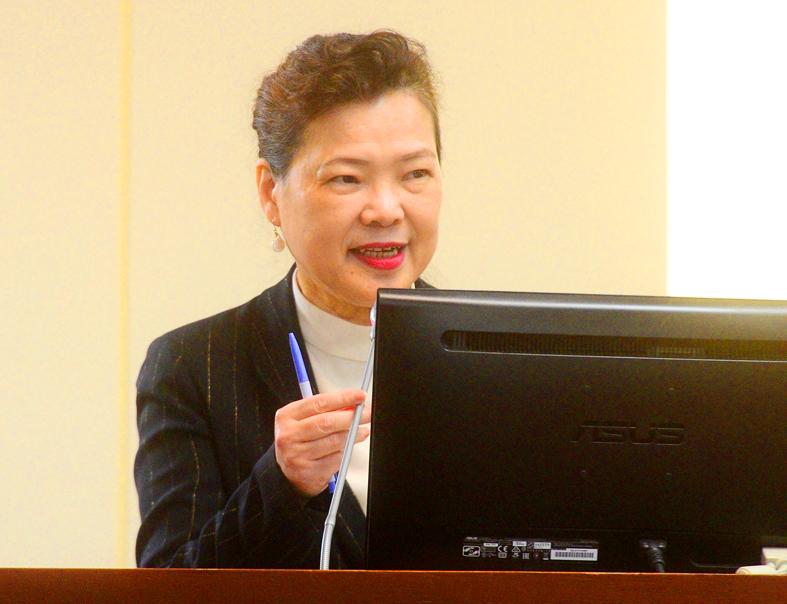The government’s energy transition plan depends on the construction of the proposed third liquified natural gas (LNG) terminal off the coast of Datan Borough (大潭) in Taoyuan’s Guanyin District (觀音) to increase LNG power generation, Minister of Economic Affairs (MOEA) Wang Mei-hua (王美花) said yesterday.
“If we do not have the third LNG terminal as planned, we will not be able to reach 50 percent electricity generation from natural gas and 30 percent electricity generation from coal” by 2025, Wang said at a meeting of the legislature’s Economics Committee in Taipei.
In December last year, 41.5 percent of Taiwan’s electricity came from coal-fired plants, 40.1 percent from natural gas, 14.4 percent from nuclear power and 5.8 percent from renewables, Bureau of Energy data showed.

Photo: Wang Yi-sung, Taipei Times
The government plans to phase out nuclear power by 2025, reduce the use of coal to 30 percent and boost renewables to 20 percent.
The two existing LNG receiving terminals are already running at full capacity, necessitating the third LNG terminal, Wang said.
Democratic Progressive Party Legislator Chiu Chih-wei (邱志偉) asked Wang whether the ministry has a backup plan if a referendum to block the terminal plan prevails.
“As of now, there is no plan B,” Wang said. “The MOEA calls for the swift construction of the third LNG terminal to reduce the amount of coal burned.”
“Gas from the third LNG terminal would fulfill the power needs of 10 million Taiwanese and close the power gap in the north of Taiwan,” Wang said. “This would allow us to generate power where it is used, lowering systemic risk.”
LNG power generation releases approximately 50 percent less greenhouse gas than coal-fired power generation, and much fewer pollutants.
The 5,824 megawatt Taichung Power Plant is the third-largest coal-fired plant in the world and is often fined by the Taichung City Government for using too much coal.

Shares in Taiwan closed at a new high yesterday, the first trading day of the new year, as contract chipmaker Taiwan Semiconductor Manufacturing Co (TSMC, 台積電) continued to break records amid an artificial intelligence (AI) boom, dealers said. The TAIEX closed up 386.21 points, or 1.33 percent, at 29,349.81, with turnover totaling NT$648.844 billion (US$20.65 billion). “Judging from a stronger Taiwan dollar against the US dollar, I think foreign institutional investors returned from the holidays and brought funds into the local market,” Concord Securities Co (康和證券) analyst Kerry Huang (黃志祺) said. “Foreign investors just rebuilt their positions with TSMC as their top target,

H200 CHIPS: A source said that Nvidia has asked the Taiwanese company to begin production of additional chips and work is expected to start in the second quarter Nvidia Corp is scrambling to meet demand for its H200 artificial intelligence (AI) chips from Chinese technology companies and has approached contract manufacturer Taiwan Semiconductor Manufacturing Co (TSMC, 台積電) to ramp up production, sources said. Chinese technology companies have placed orders for more than 2 million H200 chips for this year, while Nvidia holds just 700,000 units in stock, two of the people said. The exact additional volume Nvidia intends to order from TSMC remains unclear, they said. A third source said that Nvidia has asked TSMC to begin production of the additional chips and work is expected to start in the second

REVENUE PERFORMANCE: Cloud and network products, and electronic components saw strong increases, while smart consumer electronics and computing products fell Hon Hai Precision Industry Co (鴻海精密) yesterday posted 26.51 percent quarterly growth in revenue for last quarter to NT$2.6 trillion (US$82.44 billion), the strongest on record for the period and above expectations, but the company forecast a slight revenue dip this quarter due to seasonal factors. On an annual basis, revenue last quarter grew 22.07 percent, the company said. Analysts on average estimated about NT$2.4 trillion increase. Hon Hai, which assembles servers for Nvidia Corp and iPhones for Apple Inc, is expanding its capacity in the US, adding artificial intelligence (AI) server production in Wisconsin and Texas, where it operates established campuses. This

Garment maker Makalot Industrial Co (聚陽) yesterday reported lower-than-expected fourth-quarter revenue of NT$7.93 billion (US$251.44 million), down 9.48 percent from NT$8.76 billion a year earlier. On a quarterly basis, revenue fell 10.83 percent from NT$8.89 billion, company data showed. The figure was also lower than market expectations of NT$8.05 billion, according to data compiled by Yuanta Securities Investment and Consulting Co (元大投顧), which had projected NT$8.22 billion. Makalot’s revenue this quarter would likely increase by a mid-teens percentage as the industry is entering its high season, Yuanta said. Overall, Makalot’s revenue last year totaled NT$34.43 billion, down 3.08 percent from its record NT$35.52